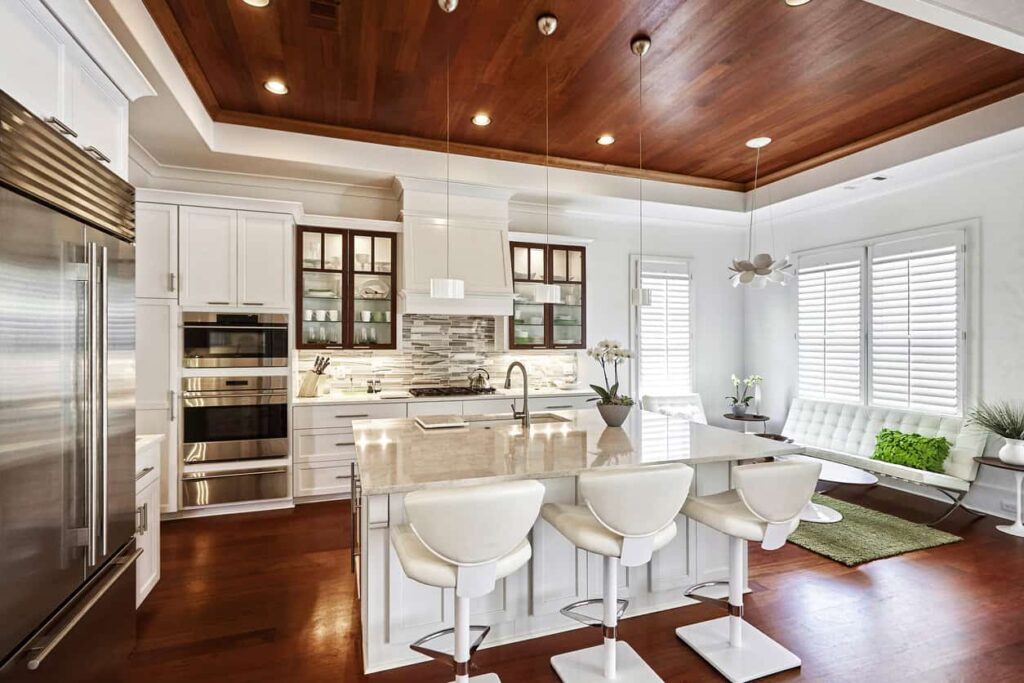With restaurant-style features and heavy-duty construction, prosumer kitchen gear promises a higher level of culinary performance.

You can’t flip on a television these days without seeing a celebrity chef. And in our celebrity-obsessed culture, the fact is we always want more. Not content to simply admire them on the screen, we book tables at their restaurants, snatch up their latest cookbooks and strive to emulate them at home. The desire to perform like the pros has prompted consumers to install pro-style gear in their home, creating the “prosumer” kitchen.
What Exactly is a Prosumer Kitchen?
The word “Prosumer” is a hybrid of the words professional and consumer. A prosumer kitchen is an upgraded kitchen that allows us to cook at home with the same level of equipment as professional chefs.
The prosumer trend is the result of watching chefs perform on television and watching them cook in open restaurant kitchens,” says Steve Kleber, immediate past president of the Center for Kitchen & Bath Education and Research.
Motivated by power, control, speed and easy cleanup – or simply fashion – homeowners are springing for pro-style kitchen appliances like high-heat ranges and cooktops, home barista machines, large-capacity refrigerators and freezers, multiple sinks, wall-mounted pot-fillers, deep-fryers, countertop or convection toaster ovens and even wood-fired pizza ovens.
This demand has in turn motivated manufacturers to offer a suite of new products and appliances that were previously available only to professional restaurant kitchens.
How the Prosumer Kitchen Trend Started
What really kicked this trend into high gear, was when manufacturers like Viking began offering commercial-style ranges that looked like professional ranges, performed like professional ranges, but didn’t require all the costly fire-prevention modifications of true commercial equipment.
Alan Abrams – a Certified Master Kitchen Designer & Bath Designer (CMKBD).
Unlike actual commercial equipment, these new ranges can be placed against a wall, sided by wood cabinetry and don’t require special hood-mounted fire-suppression systems.
Difference Between a Prosumer and a Traditional Kitchen Design
Like the professional restaurant kitchen, the prosumer kitchen is divided into work zones for multiple cooks and tasks. As opposed to the “work triangle” of regular kitchens where one cook, traditionally the lady of the house, moved from fridge to stove to sink, today’s prosumer kitchen provides ample space for numerous cooks to work on various jobs.
The modern kitchen features multiple water sources, a variety of work surfaces, high-arching quality faucets for filling large stockpots, open shelving and hanging pot racks for quick access to kitchen cookware.

Is it right for you?
This trend isn’t limited only to the most affluent of home cooks. A majority of homes today are adopting at least some of these prosumer characteristics into their kitchen design.
Indeed, the majority of modern kitchen design trends now originate in professional restaurant kitchen. When stainless steel now appears on appliances all the way down to entry-level models, it shows how pervasive this trend has become.
Of course, the willingness of the homeowner to part with hard-earned cash will determine whether he or she cooks like a pro or just looks like one. There are many different levels of prosumer. The passionate home cook who collects cookbooks, subscribes to all the magazines, and takes cooking classes to hone his or her skills may want something as close to an authentic professional kitchen as possible.
Interestingly enough, it is often style – not cost – that determines just how far the high-end prosumer will go to keep pace with a bona fide professional restaurant kitchen.
Conclusion
True professional kitchens are designed to be antimicrobial, easy to clean, scratch- and scuff-resistant and fire retardant. This translates into a sea of stainless steel, with no tolerance for wooden cabinetry, butcher-block countertops or that cushy armchair by the window. Today’s prosumer kitchen has to be fashionable as well as practical.
The prosumer cooking experience also needs to be pleasurable. Features like sound-deadening pads in stainless sinks, while wholly unnecessary in professional kitchens, find their way into today’s home models. Other sink amenities include slots for filtered water, instant hot faucets, and soap and lotion dispensers.
Budget-minded home cooks aren’t excluded from the prosumer trend. There are fewer costly ways of introducing professional-style features into the kitchen design.
All appliances, from high- to low-end models, now offer stainless steel finishes, which give them the look and feel, if not performance, of pro-style appliances for considerably less money.
Other cost-conscious approaches include installing high-arching faucets, deep, under-mounted stainless-steel sinks and utilizing open-wire shelving for quick access to pots and pans. But then you need to invest in attractive cookware.